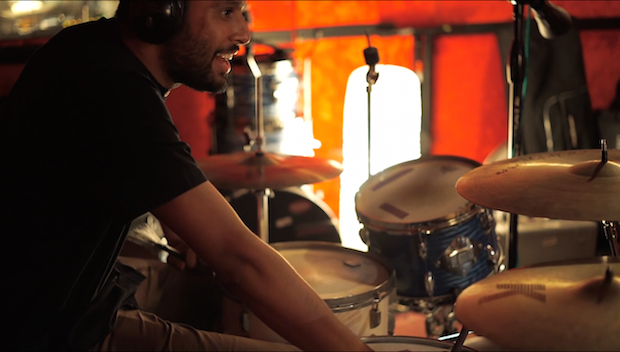
Screencap via Soundfly video
This article originally appeared on Soundfly.
For many musicians, the idea of recording a demo can seem a bit daunting, especially when taking a do-it-yourself approach. Fortunately for those of us who need a bit of guidance, Black Lodge Recording’s Vishal Nayak has helped the Soundfly team create a brand new course, full of tips for efficient, effective, and stress-free demo production. DIY Production Techniques: Demo Recording 101 can help you take your demo from conception to completion.
One of the first things you’ll need to do (after setting up your scratch track) is to set the tempo for the whole song by recording your drum parts. In the demo recording course, we focus on recording a live drum kit using two microphones. Here are some pointers to help you do it right.
1. Take the time to tune your drums and pick cymbals that suit the song
If you have some options, try playing the song’s groove on different drums before you start setting up microphones.
2. Carefully position your microphones
For the purposes of recording a demo, we’re assuming you don’t have access to a whole studio’s worth of gear. We picked two microphones and placed them strategically to best capture both the overall drum sound, and to highlight the kick. Vishal placed a condenser mic, the Audio-Technica 4047, about three feet above the snare drum in order to capture the overall sound of the kit. And he used a dynamic mic, the Shure SM57, positioned in front of the kick drum.
3. Get the drummer's headphone mix right
Once the drums and mics are ready to go, take a moment to make sure the drummer is happy with the headphone mix. It’s important to make sure the track and click are nicely balanced.
4. Do a few takes
It's always a good idea to give yourself some options, so record a few takes. Once you’ve done that, listen back and jot down some notes regarding what you like and don’t like about each take. Then you’ll be able to efficiently compare them in order to decide which one take (or which parts from different takes) you’d like to use on your demo.
If you’re using Logic Pro, keep learning with the Demo Recording 101 course and see how to group your drum tracks, check the phase between the two mics, and start comping multiple takes into the ideal drum track for your demo.
Mahea Lee is a classically trained pianist and composer who has a degree from a jazz school and leads an electro-pop band. Her greatest musical passion is lyrical songwriting, but she's been known to write the occasional fugue. She graduated from Berklee College of Music, where she majored in contemporary writing and production and minored in music theory. For more Mahea, check out Soundfly's course, The Improviser's Toolkit.







